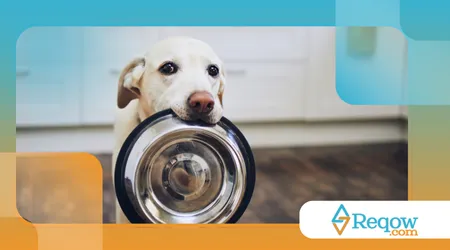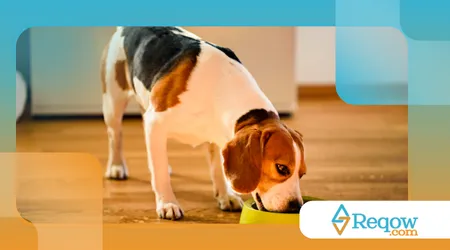How to deal with dogs that are possessive about food.

Learn to dealing with dogs that are possessive about food It is fundamental for the safety and harmony of your home.
Advertisements
Guarding behavior is natural in dogs, a remnant of their evolutionary heritage. However, when possessiveness turns to food, the situation demands immediate attention and proper handling.
This protective attitude, if left unchecked, can escalate into aggression, compromising coexistence.
Food possessiveness, or resource guarding, manifests itself in various ways. The dog may growl, show its teeth, or "freeze" when the food bowl is approached.
This behavior does not indicate malice; it signals a deep insecurity about the availability of the resource.
Advertisements
What Causes Food Hoarding?
Many factors contribute to the development of this possessiveness. Past experiences of competition for food may be the origin.
Dogs rescued or raised in environments of scarcity develop this defense mechanism.
Inadequate socialization is also a crucial factor in the problem. A dog that hasn't learned to trust human provision will tend to protect what it has.
Failures in communication and in establishing firm boundaries also exacerbate the issue.
Consistency in routine is vital, as unpredictability generates anxiety. The dog needs to understand that food is always guaranteed, and its presence near the bowl is positive.
Why is Positive Reinforcement the Best Approach to Dealing with Dogs Possessing Food?
A punishment-based approach is counterproductive and dangerous. Reprimanding or forcibly taking away food only increases possessiveness and distrust.
It's a path that reinforces the dog's belief that it really needs to defend its food.
Read more: Training for dogs that are afraid of fireworks
Positive reinforcement, on the other hand, transforms your approach into something pleasurable for the dog.
He gradually learns that his presence means more, not less, food. The shift in perception is key.
Imagine this situation: who among us wouldn't feel threatened if something valuable was constantly taken from them?
The dog feels the same way. We need to reverse this negative association into something positive and safe.

What are the most effective training techniques?
Desensitization and counterconditioning training is the most recommended.
The goal is to change the dog's emotional response from anxiety to positive expectation. Do this in very small steps.
Start by feeding the dog and then step back. Repeat this consistently. In the next phase, approach just close enough for the dog to notice you, but not react.
Find out more: How to Correct Excessive Barking in Dogs
Slowly decrease the distance. When the dog is eating, as you approach, throw a high-value treat near the bowl. This teaches him that your arrival is a bonus.
This process requires patience and a slow pace for success. The dog must be relaxed at all stages of training. Rushing the process can cause regression.
It's essential to never try to remove the food bowl at the beginning of treatment. The dog needs time to build a new relationship with you and the food.
Mutual trust is the foundation for dealing with dogs that are possessive about food.
| Sign of Possessiveness | Meaning for the Dog | Tutor's Action (Positive Reinforcement) |
| Growl | "Don't come any closer!" | Freeze the approach and throw a snack from a distance. |
| A "crooked" look | "I'm uncomfortable." | Speak in a calm tone and step back slightly. |
| Eat fast | "I need to finish before they take it away!" | Introduce slow feeders to reduce anxiety. |
| "Freeze" | "I am ready to defend." | Avoid eye contact and then offer something even tastier. |
How does a change in environment and routine help?
Modifying the food environment is a powerful strategy.
Feed the dog in a calm, secluded place where people and other animals cannot pass by. This eliminates the need for competition.
The use of interactive or "slow" feeders is also beneficial.
They transform the meal into a mental challenge, diverting the mind's focus. They increase consumption time and reduce the sense of urgency.
++ Why dogs love to roll in the grass
So, imagine a dog named Max. He would growl whenever his owner approached.
Instead of scolding, the tutor started "giving tips" in the form of small pieces of meat while Max ate.
After a few weeks, the arrival of the tutor meant the best part of the meal, and Max stopped growling.
How important are bonding and trust when dealing with possessive dogs regarding food?
Trust is the cornerstone for dealing with dogs that are possessive about foodYour dog needs to see you as the reliable provider of all resources.
This is built through positive and consistent interactions, both outside and during mealtimes.
A study published in the Journal of Veterinary Behavior In 2021, it was pointed out that 75% of resource hoarding cases in pet dogs were related to failures in prevention and early management, and not to an innate problem.
This data underscores the importance of early and correct intervention.
Prevention starts in puppyhood. Get your dog used to having people around during meals, always offering something better. This creates an unshakable foundation of security.

What precautions can prevent possessiveness from worsening?
Avoiding the initial situation is crucial to avoid reinforcing possessive behavior. Never try to forcibly remove the bowl or bone.
This only teaches the dog that it needs to be more aggressive next time.
If you need to remove an item (for safety reasons, for example), use the swapping technique.
Offer a much more valuable treat in exchange for the possessive item. This way, the dog learns that "letting go" brings a superior reward.
Imagine, Sofia, a Golden Retriever, protecting her bones.
Instead of scolding her, the owner started giving her the bone and, after a minute, offered her a portion of natural yogurt in a small container.
Sofia willingly gave up the bone for the yogurt. The exchange created a positive memory.
Frequently Asked Questions
Will possessiveness disappear completely with training?
With consistent and positive training, aggression and possessiveness should decrease dramatically, being replaced by trust. Ongoing management is essential.
Can I scold him if he growls?
No! Scolding only increases fear and aggression. Growling is a warning; punishing it teaches the dog to ignore the warning and go straight for the bite. Stay calm and use counter-conditioning.
Is it better to feed the dog separately from other pets?
Yes, initially. Until the problem is resolved, feed the possessive dog in a place where he feels safe and doesn't have to compete with other animals.
How long does it take to see results?
It varies a lot, but consistency is the most important thing. Initial results may appear in weeks, but consolidating the behavior can take months. Never give up!
++ How to avoid possessiveness and aggression regarding food?
